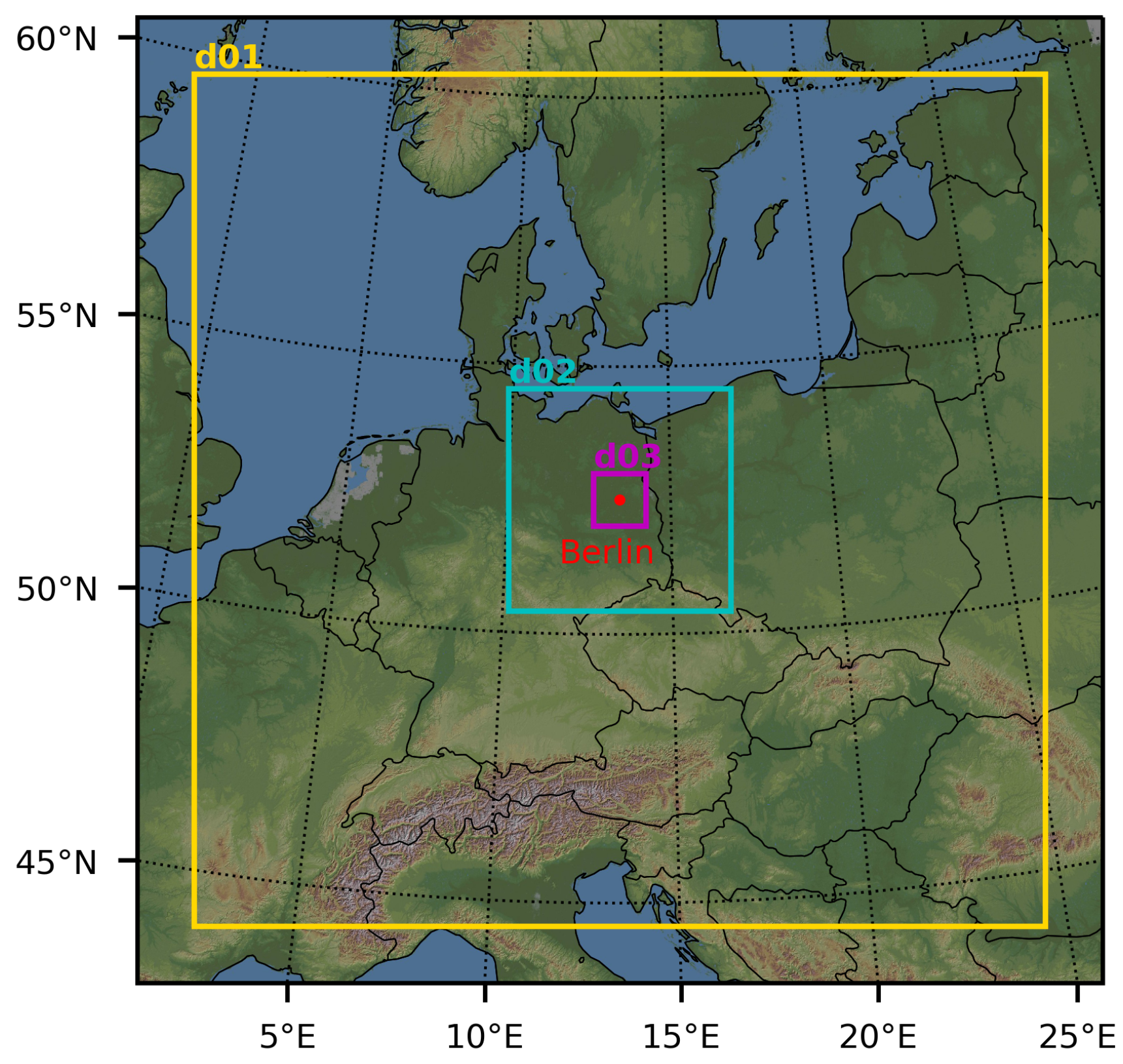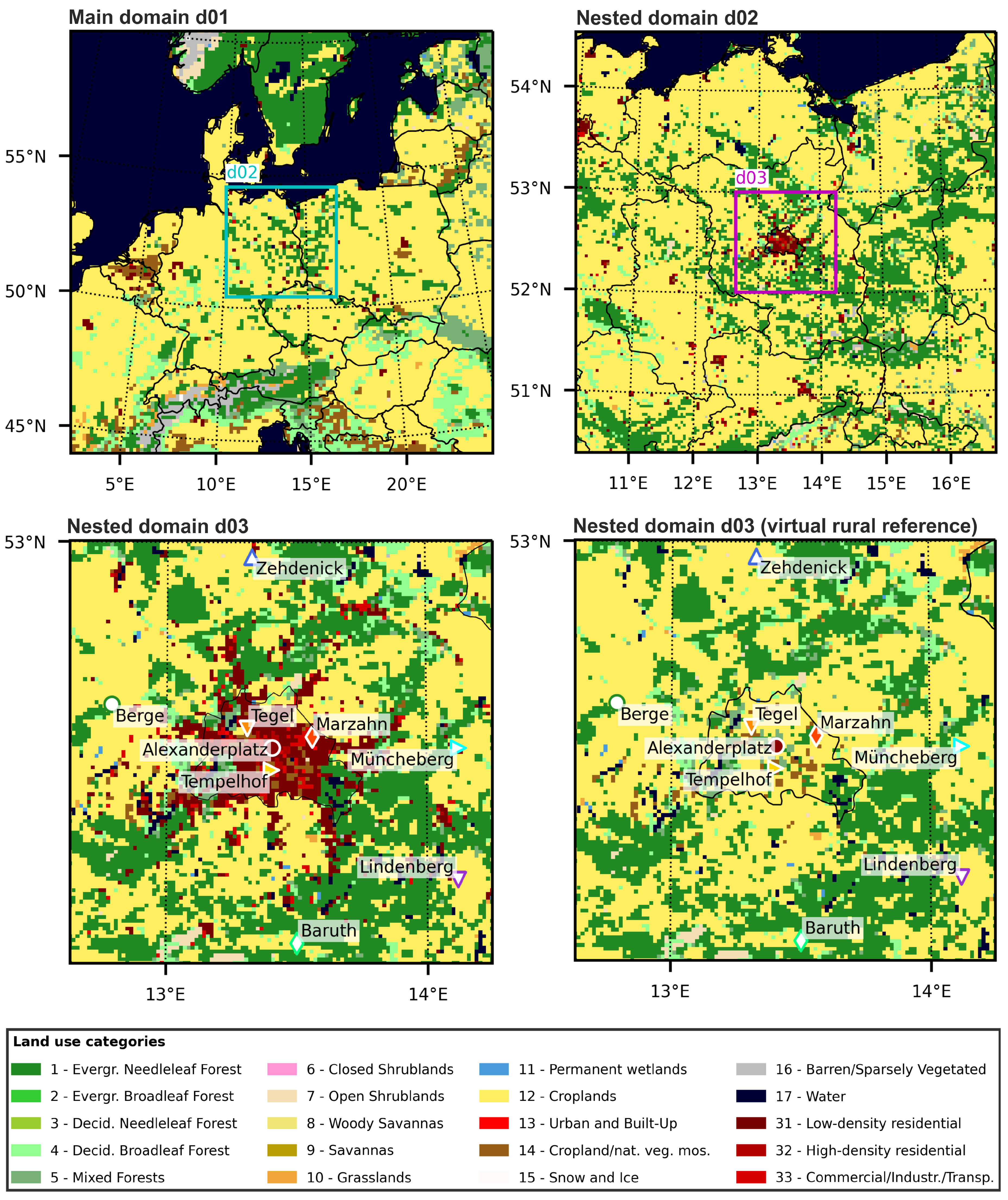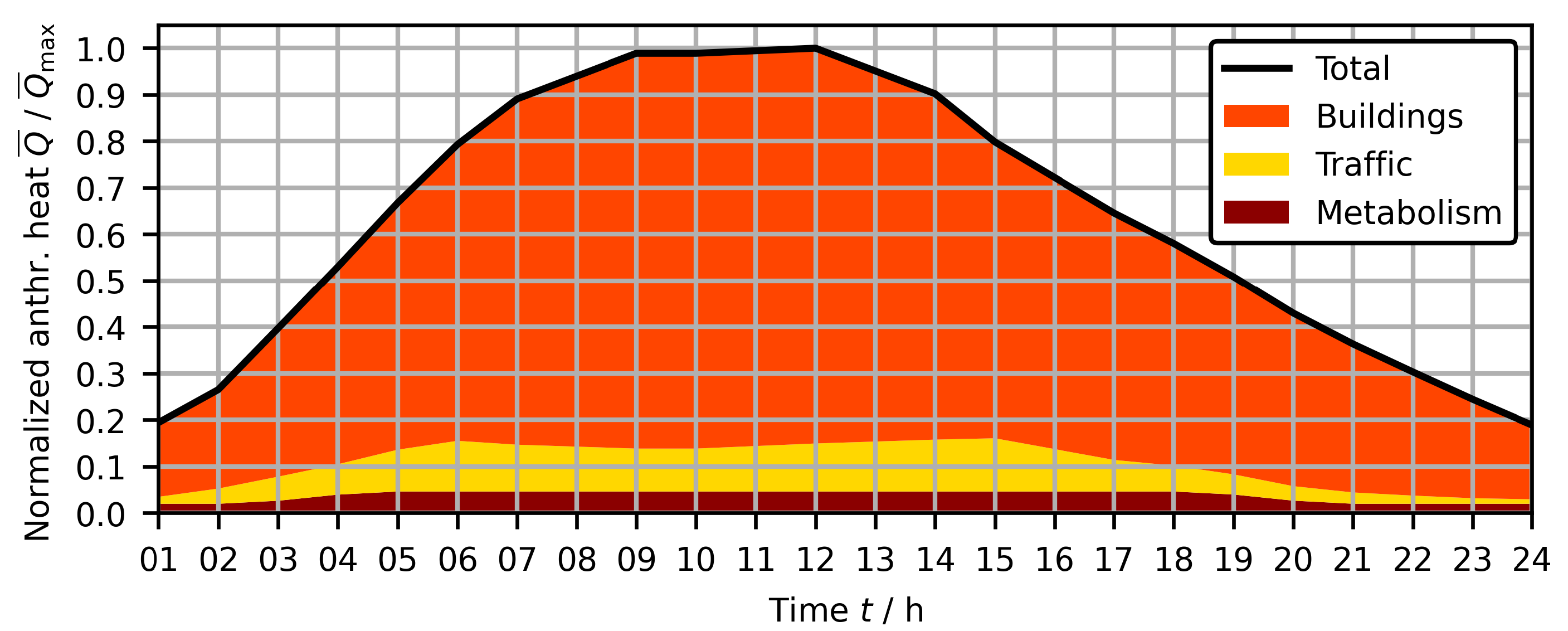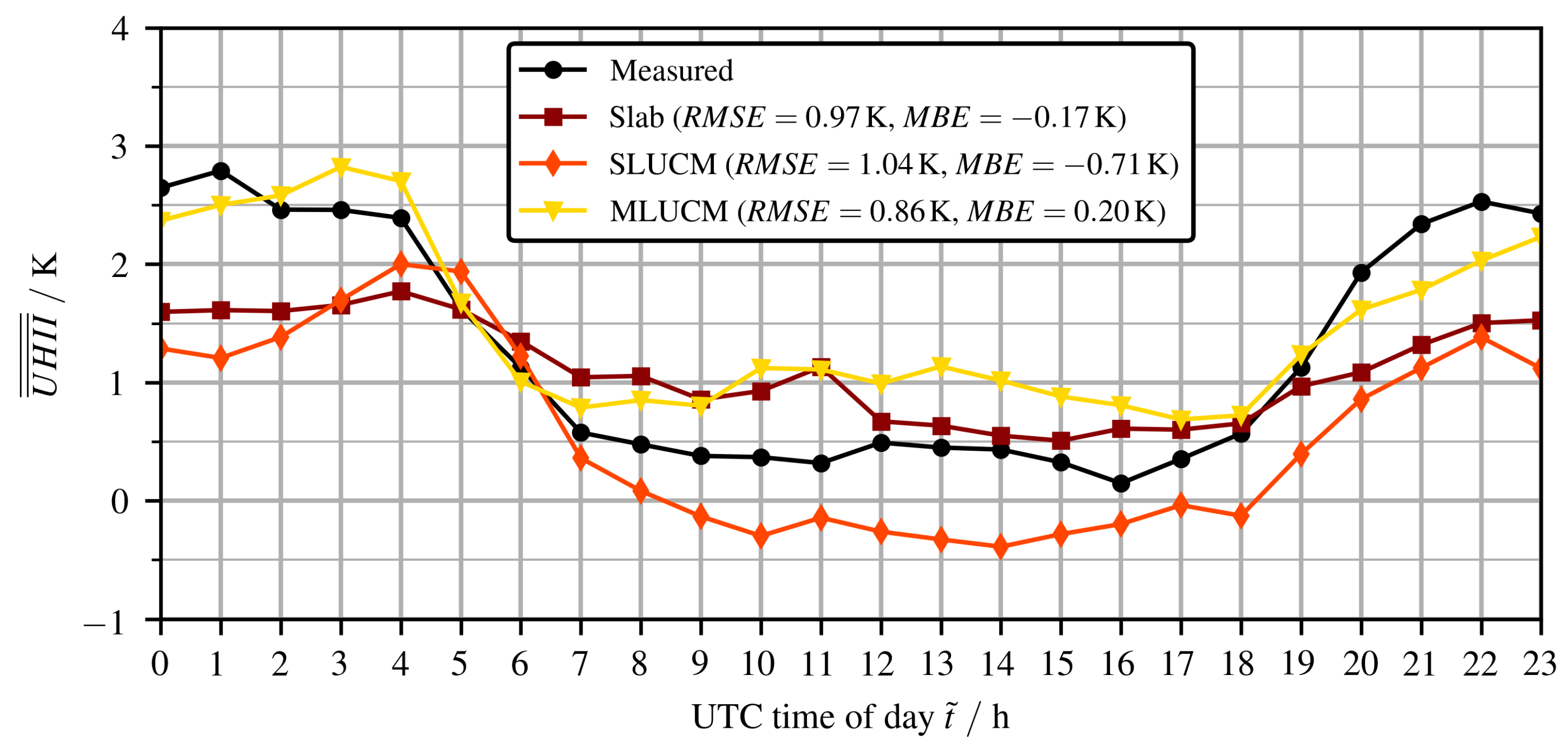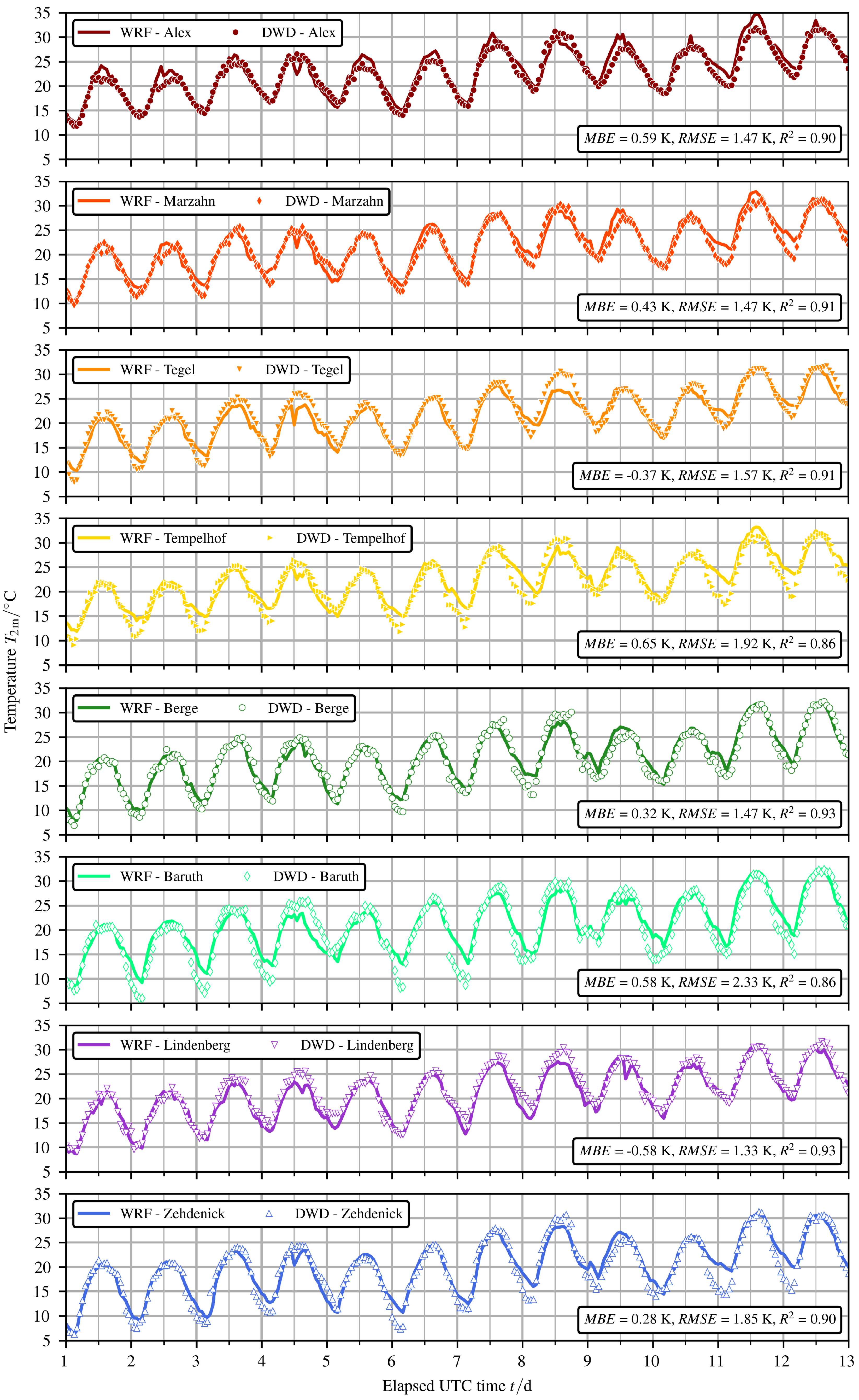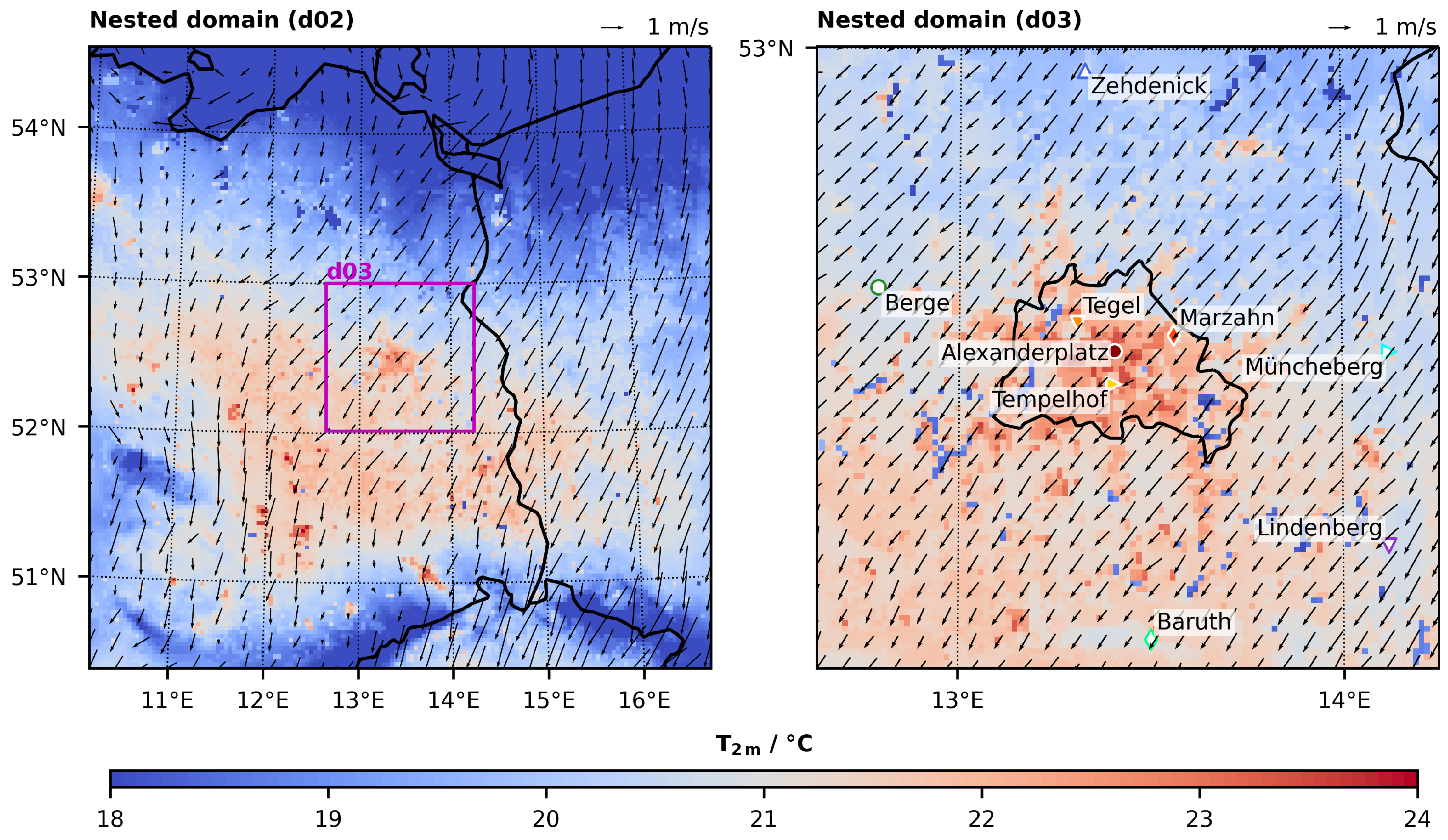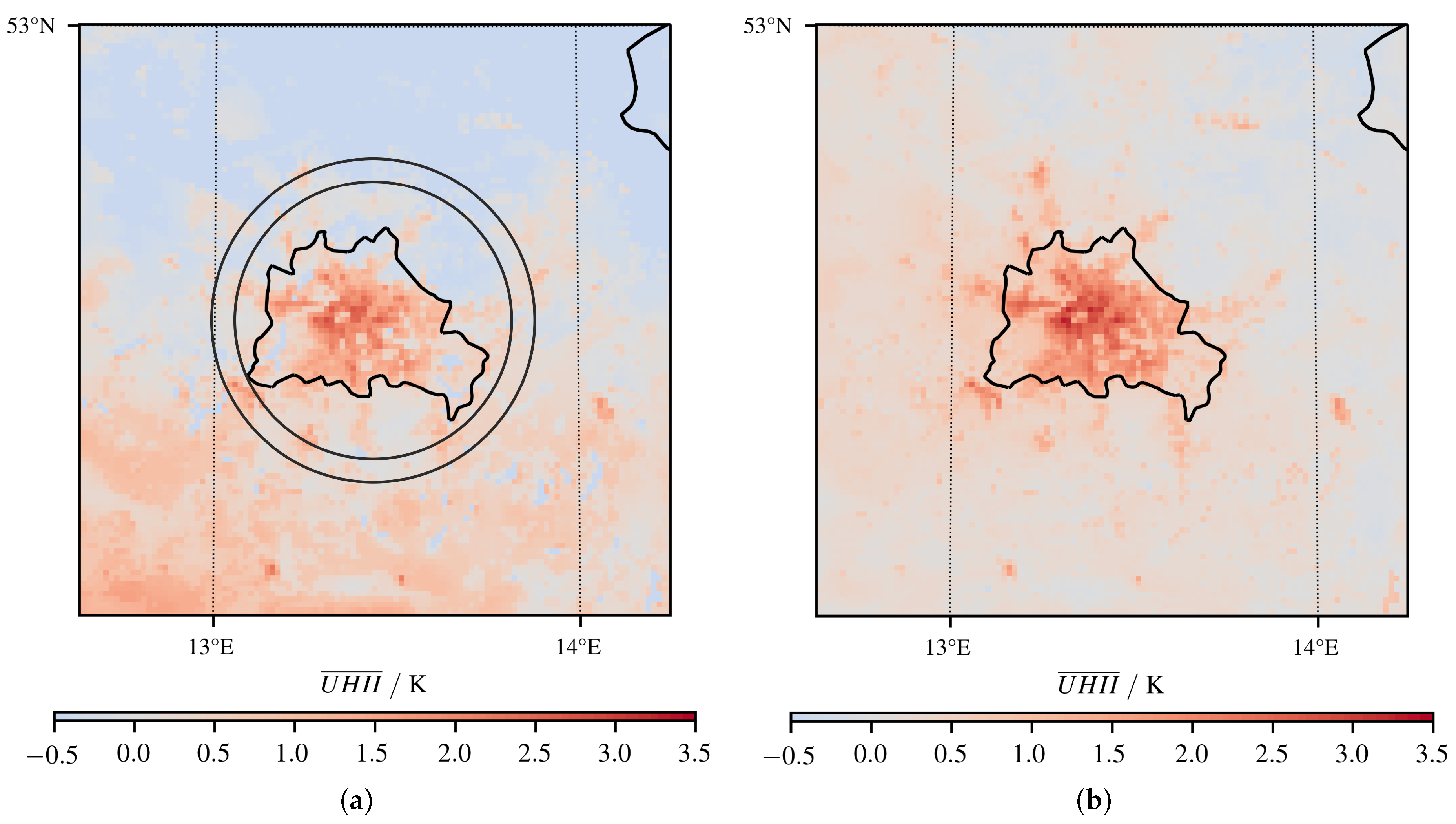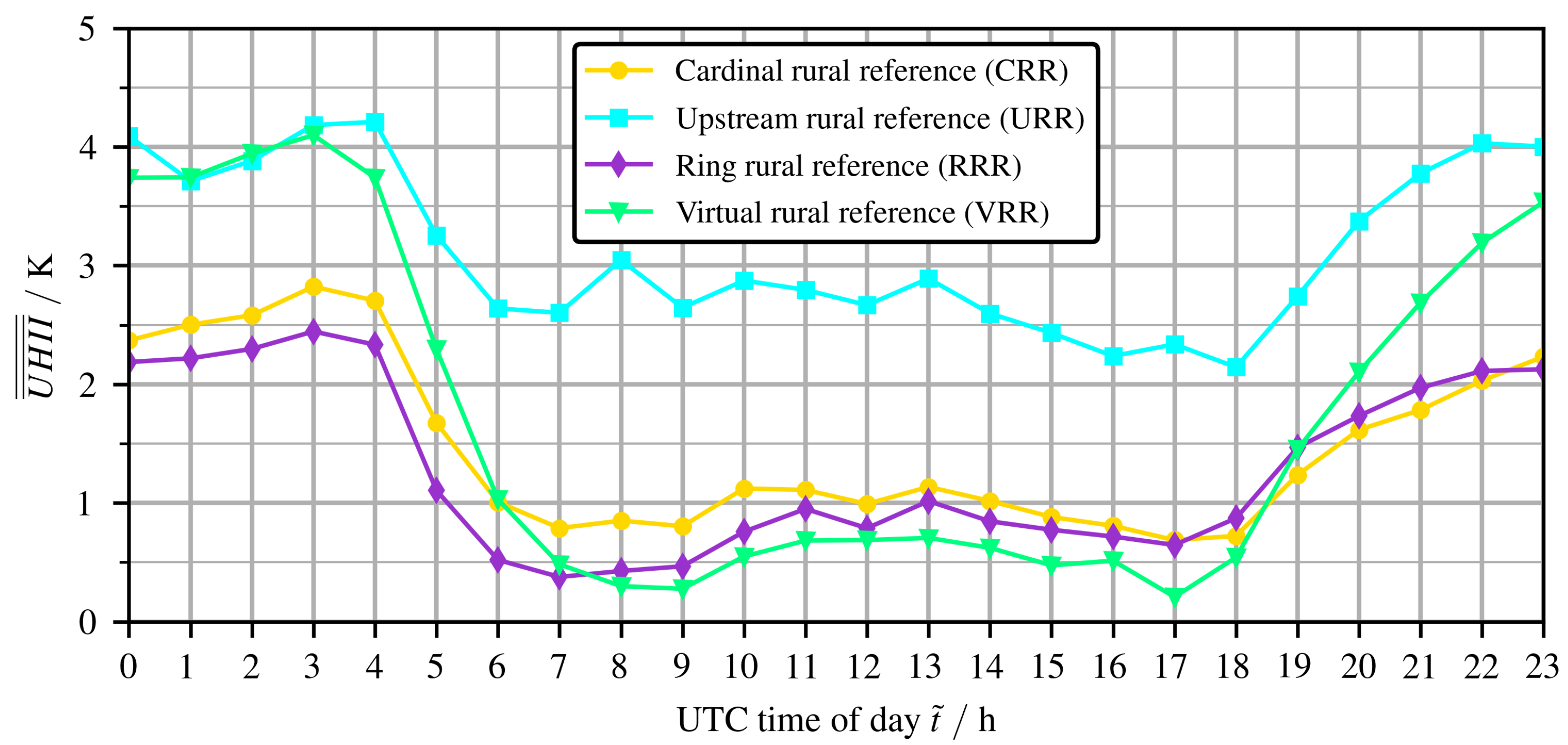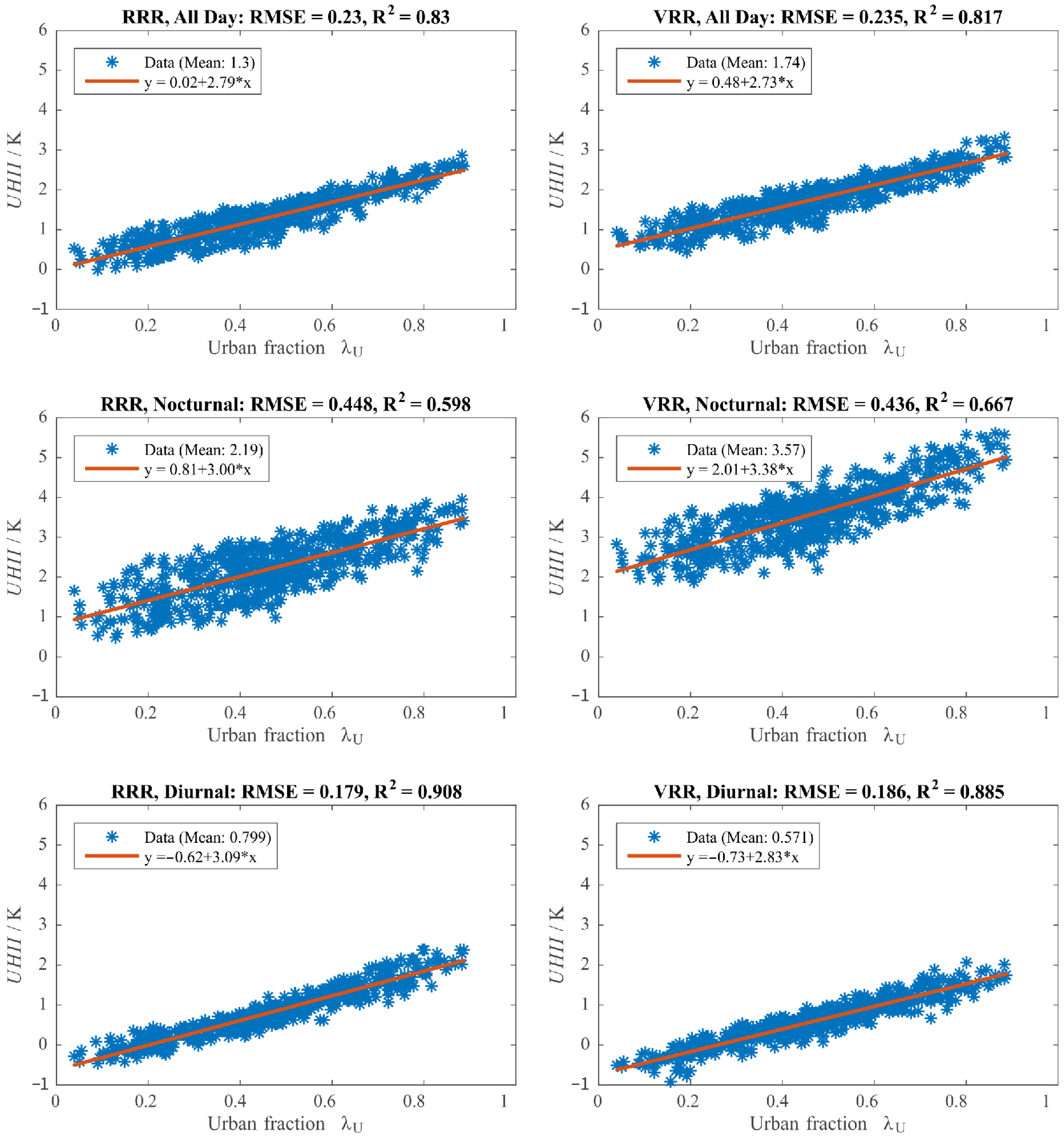1. Introduction
Until the late 1990s, the study of the urban microclimate was, to a large extent, dependent on field experiments [
1]. This could be explained in part by the inability of mesoscale numerical weather prediction software such as Weather Research and Forecasting (WRF) [
2] and COSMO [
3] (Consortium for Small-Scale Modeling) to properly model complex physical phenomena occurring within and at the interfaces of the urban canopy. Typically, the “bulk” or “slab” approach [
4] would be adopted whereby the urban soil properties (heat capacity, thermal conductivity, surface albedo, aerodynamic roughness length, etc.) used in the surface heat balance equation were modified in order to distinguish the urban area from the surrounding rural area [
5]. While this approach, where buildings are modeled via increased roughness in urban areas, is associated with a low number of parameters and is easily coupled with the atmospheric model [
6], it does not properly represent the geometric characteristics of urban areas [
7]. In particular, it does not provide an accurate estimate of the conditions within urban canyons.
As a result, it was proposed to couple land surface models (LSM) with more sophisticated urban canopy models (UCM) [
8,
9]. In particular, the single-layer urban canopy model (SLUCM) was introduced by Masson [
10] and Kusaka et al. [
11] while Martilli [
12] presented a multi-layer urban canopy model (MLUCM) called building environment parameterization (BEP). SLUCM represents shadowing, reflection and radiation trapping in the street canyon using a generic infinitely long street canyon described by the mean building height/width and street width. Within the urban canyon, an exponential profile is specified for the wind profile and thermal homogeneity is assumed for the urban canopy air which only interacts with the atmosphere at the top of the urban canyon. MLUCM accounts for the three-dimensional nature of urban surfaces and treats the buildings as sources and sinks of heat, moisture and momentum. It allows a direct interaction with the planetary boundary layer (PBL). Schubert et al. [
13] later developed a double canyon effect parametrization (DCEP) UCM for COSMO, based on the BEP. Salamanca and Martilli [
14] added a building energy model (BEM) to the standard BEP. An equivalent scheme in COSMO, called DCEP–BEM, was presented by Jin et al. [
15]. The BEM calculates heat transfer through the building envelope and determines the cooling/heating energy needed to maintain a certain indoor air temperature. Crucially, the impact of the waste heat of the indoor air conditioning system, rejected into the street canyon, is accounted for.
In WRF, both SLUCM and MLUCM schemes include the impact of anthropogenic heat, albeit in entirely different ways. In SLUCM, the anthropogenic heat or rather its average daily profile is provided by the user. Sailor described different methods for estimating anthropogenic heat for urban canopy models [
16]. One way to estimate the average daily profiles of anthropogenic heat for SLUCM is by using the large scale urban consumption of energy (LUCY) model [
17] which derives average daily profiles from a country-wide energy budget analysis. Although it is possible in the SLUCM scheme to set different daily profiles for each urban category, the profiles are assumed to be constant throughout the year; i.e., the seasonal variation is not considered. This can be problematic in low/mid-latitude cities where the waste heat originating from air conditioning systems significantly affects urban air temperatures, mainly in summer time [
18]. In contrast, in MLCUM, the anthropogenic heat is exactly equal to the building air-conditioning waste heat and is calculated automatically by the BEM, taking the seasonal weather-dependent variation fully into account. However, it is, currently not possible to add non-building related anthropogenic sources, such as heat generated by motorized vehicles or industrial sites, to the standard WRF implementation of the BEP + BEM model.
One of the most studied aspects of the urban microclimate is the urban heat island (UHI). The UHI phenomenon results from the entrapment of the solar radiation in street canyons, the storage of heat in man-made structures having high thermal mass and low-albedo surfaces, the attenuation of wind speed by buildings, the drastically reduced evaporative cooling and the anthropogenic heat generation [
19]. The UHI results in urban temperatures that are, on average, higher than rural areas immediately surrounding the city, especially at night when the heat stored during the day is gradually released. The urban-rural temperature differential is referred to as the UHI intensity. It is customary to measure the accuracy of urbanized mesoscale models by their ability to predict the urban canopy near-surface temperature and, specifically, the UHI intensity; a secondary criterion is the urban wind flow characteristics [
5,
20]. Most often, the temperature of the urban area is compared to that of one or several reference rural locations in the immediate vicinity of the city. Typically, the selected rural sites correspond to the locations of pre-existing weather monitoring stations (e.g., airports). In contrast, Bohnenstengel et al. [
21] proposed to perform two simulations, one with the actual urban surfaces and a second virtual simulation where the urban surfaces are replaced with a locally prevalent vegetation type (grass, in their study of UHI in London). This approach has the advantage of not relying on the more or less arbitrary choice of one or several reference rural sites. Furthermore, it is the approach that is the most congruent with the theoretical definition of the UHI since it truly calculates the impact of the so-called “urban increment” on the local meteorology. However, given that the calculation procedure is based on a hypothetical (or virtual) rural reference, a direct validation against measurements is impossible.
The proper selection of the mesoscale model options is a hotly debated topic among researchers. This selection is usually based on the comparison of simulation results to observations in different cities. In WRF, the main options of the mesoscale model are the planetary boundary layer (PBL) physics scheme, the microphysics scheme, the short-wave/long-wave radiation schemes, the land surface model and the grid size. In addition, the user can decide between different land-use/land-cover data sources and urban fraction calculation procedures. The short-wave/long-wave scheme is very often either Dudhia/Rapid Radiative Transfer Model (RRTM) or Goddard/RRTM [
2] while the lower limit of the grid size of the innermost domain containing the urban area of interest is often 1
in order to avoid the “terra incognita” or “grey zone” range, where turbulence modeling can become problematic [
22]. Jänicke et al. [
23] observed that, in Berlin, errors in near-surface air temperature strongly depended on the selected PBL scheme. They tested the Bougeault-Lacarrère (BouLac) and the Mellor–Yamada–Janjic (MYJ) PBL schemes [
2] and found that the former performed better. Nemunaitis-Berry et al. [
24] compared two WRF planetary boundary schemes, the MYJ and the YSU, in combination with the SLUCM, for the evaluation of the UHI over Oklahoma City. They observed that regardless of the PBL scheme used, the model significantly overestimated near-surface air temperature during daytime hours for both urban and rural grid points. Li et al. [
25] evaluated the impact of land cover data on the simulation of the UHI in Berlin by comparing up-to-date fine-resolution CORINE (Coordination of Information on the Environment) land cover and Urban Atlas data with older coarse-resolution USGS (US Geological Survey) data. They showed that the former simulation approach performed better than the latter for both air and land surface temperatures. Li et al. [
26] introduced a new method to estimate UHI intensity in Berlin. Their method is based on the fitted linear functions of simulated two-meter air temperature using the impervious surface area in WRF grids. They compared simulation results to observations and reported an RMSE of
. Hammerberg et al. [
27] compared the relative impact of using the WUDAPT (World Urban Database and Access Portal Tool) methodology versus a simplified definition of the urban morphology extracted out of detailed GIS information to initialize WRF. They conducted a case study over Vienna, Austria using the BEP+BEM UCM scheme and demonstrated that using detailed GIS data to derive morphological descriptions of local climate zones (LCZ) provided only a marginal overall improvement over using default WUDAPT parameters. Wong et al. [
28] evaluated WRF urbanized with BEP+BEM over the Pearl River Delta region and determined that WUDAPT is a suitable alternative in regions where a more detailed dataset is not available, provided that building morphology for different LCZs is estimated based on local expertise with a subgrid-averaging approach. Salamanca et al. [
29] coupled the WRF UCMs with the new Noah multi-parameterization LSM (Noah-MP, cf. [
2]) during a 15-day clear-sky summertime period for a semi-arid urban environment. According to their results, Noah-MP is superior to Noah for the estimation of the daily evolution of near-surface air temperature and wind speed. When it comes to the choice of the UCM scheme, the MLUCM provides a more realistic reproduction of the daily evolution of the near-surface wind speed.
Another active area of research is the proper choice of the UCM scheme in a mesoscale model. In a WRF-based study of the UHI in Houston, Salamanca et al. [
20] concluded that, if the purpose of the simulation is to estimate the near-surface air temperature, a simple bulk scheme is sufficient; but if the simulation is aimed at evaluating a UHI mitigation strategy, a more complex UCM should be used. Studying the UHI in the Tokyo metropolitan area using WRF, Kusaka et al. [
30] found clear evidence in favor of the SLUCM when compared to the slab scheme. Schubert and Grossman-Clarke [
31] evaluated the DCEP urban canopy model (DCEP is the COSMO implementation of BEP) against data from the Basel urban boundary layer experiment (BUBBLE). They showed that, in comparison to the bulk approach, the application of the BEP scheme improves the sensible, latent and storage heat fluxes at the urban and suburban stations. Jänicke et al. [
23] compared near-surface air temperature modeling error and concluded that the simple slab UCM outperformed the more elaborate UCMs. Trusilova et al. [
32], evaluated UHI intensity in Berlin using COSMO. At Alexanderplatz—the most dense urban location—the multi-layer UCM best captured the daily evolution of the UHI in summer while the bulk UCM was superior in winter. Jandaghian and Berardi [
33] applied different WRF UCMs to characterize UHI in Toronto. They concluded that, although the single-layer scheme is reliable for climate simulations, the multi-layer scheme predicts the diurnal variation of the urban ambient temperature more precisely. Teixeira et al. [
34] concluded that the multi-layer urban canopy model improves the representation of the urban boundary layer of Lisbon in WRF compared to a single-layer approach. In particular, the increase of vertical resolution in the multi-layer model leads to planetary boundary layer height bias reduction compared to radiosonde observations. Wong et al. [
28] concluded that, in comparison with measurements from surface stations over an urban area, the BEP+BEM UCM of WRF is better at simulating wind speed than the bulk UCM. Furthermore, the improvement from a multi-layer UCM scheme is greater than that from a non-local PBL scheme over the urban area. Jin et al. [
15] compared the simulation results of the DCEP-BEM urban canopy model of COSMO with observations of radiative and turbulent energy fluxes, near-surface air temperature, and indoor air temperature in Berlin. They reported improved model accuracy in comparison to the DCEP-only scheme.
Numerous studies have focused on the sensitivity of near-surface WRF model predictions to the internal parameters of the UCM. Most of these studies aim to assess the impact of urban warming mitigation measures such as cool/green surfaces, building envelope retrofits, etc. Typically, the UCM (with the notable exception of the slab scheme) is configured by many parameters. For instance, the SLUCM in WRF has approximately 30 different parameters [
35]. While earlier studies tended to use default values of these parameters [
12,
36], more recent studies have devoted significant effort to the investigation of the impact of these parameters. Nemunaitis-Berry et al. [
24] conducted a sensitivity of the SLUCM scheme in WRF. They concluded that sensible heat fluxes are significantly affected by the albedo and the thermal conductivity of building roofs. However, latent heat fluxes are only affected by the urban fraction. Miao et al [
37] analyzed the sensitivity of a WRF/Noah/SLUCM simulation of Beijing to building heights and anthropogenic heat flux. Schubert and Grossman-Clarke [
38] used COSMO with DCEP to evaluate the influence of green areas and roof albedos on air temperatures during extreme heat events in Berlin. Their results show that the average urban air temperature can be reduced by up to
for the combined vegetation and albedo case. Morini et al. [
39] studied the impact of increased urban albedo on UHI based on a simulation of the city of Terni using WRF coupled with the BEP+BEM urban scheme. When the albedo of the roof, walls and road of the whole urban area is increased, UHI is shown to decrease by up to 2
. In a sensitivty study using WRF coupled with a bulk UCM scheme, Fallmann et al. [
40] showed that, in Stuttgart, a change in urban albedo values has the highest impact on near-surface temperatures compared to an increase of urban green areas or a decrease of building density. The UHI in the study area decreased by up to 2
by using high-albedo paints. Salamanca et al. [
41] used WRF coupled with BEP+BEM to show that, in Houston, the air-conditioning waste heat is responsible for an increase in the air temperature of up to 2
. Jin et al. [
42] applied the DECP-BEM model to assess the sensitivity of the urban canopy air temperature to air-conditioning waste heat in Berlin. Compared with a reference scenario without air-conditioning, the scenario with air-conditioning resulted in a temperature increase of up to
.
In this study, we present a meso-scale WRF simulation of the urban microclimate in Berlin, Germany. The objective is to derive an accurate estimation of the near-surface urban heat island while also retaining a good station-by-station accuracy (there are four urban and five rural stations). In comparison to previous microclimate studies of Berlin, the manuscript contains several novelties. In particular, (i) the use of the mid-resolution Copernicus Impervious Density data as urban fraction and the Corine Land Cover for the mapping of the urban fractions to the urban categories, (ii) the incorporation of a LUCY-based anthropogenic heat profile in the SLUCM, (iii) the use of high-resolution Berlin City Geography Markup Language (CityGML) data for the estimation of the building height densities required by the MLUCM and, finally, (iv) the comparison of several UHI intensity calculation methods.
Section 2 describes the case study and the methodology.
Section 3 contains the main simulation results and their discussion.
Section 4 presents our conclusions and the future research outlook.
3. Results and Discussion
We focused on two different investigations: (i) the first step was an assessment of the sensitivity of model accuracy to variations of physical and urban parameterizations, which led us to select the combination that produces the most accurate estimation of the UHI intensity; (ii) the second step was a comparison of different UHI intensity evaluation methods.
3.1. Sensitivity Analysis
To evaluate model accuracy, we used data for the period of interest from nine meteorological monitoring stations operated by Deutscher Wetterdienst (DWD) [
54] in hourly resolution. We evaluated temperature measurements at 2
height (
) from four urban and four rural stations, and wind speed measurements at 10
height (
) from two urban and two rural stations. Our selection of DWD stations is compiled in
Table 9.
To compare the WRF model to DWD measurement data, we used the Mean Bias Error (MBE) and the Root Mean Square Error (RMSE) as error metrics:
To evaluate the performance of different physical and urban parameterizations, we tested several feasible combinations. The WRF simulation results were evaluated at the nine locations of the monitoring stations given in
Table 9 and compared to their measurements. The evaluation period starts after the first day has passed at 22 June 2010 00:00 UTC, since the first day was regarded as spin-up period.
We tested several combinations of physical parameterization schemes by varying the microphysics (M-P) scheme, the planetary boundary layer (PBL) and associated surface layer (SL) schemes, the land surface model (LSM), and the shortwave (SW) and longwave (LW) radiation schemes. For this initial sensitivity analysis, the urban canopy was parameterized using the SLUCM model. The resulting error metrics for the different combinations are shown for
and
in
Table 10. On the one hand, we calculated the RMSE including all measurement stations as a primary metric. On the other hand, we calculated the MBE separately for urban and rural stations to see if there is a difference in bias between simulating urban and rural regions, because such a bias would wrongly increase the UHI intensity.
Based on the results of this first stage, we decided to retain the combination “P1” in
Table 10, because this combination led to the lowest overall RMSE and acceptable MBE for urban and rural DWD stations. In the next stage, we analyzed different urban schemes, i.e., the slab model, the single-layer urban canopy model (SLUCM) and the multilayer urban canopy model (MLUCM), which consisted of the Building Effect Parameterization (BEP) coupled to the Building Energy Model (BEM). It should be noted that the results for the urban parameterizations may differ using a different combination of physical schemes. These results correspond to a predominantly dry and low-wind period. The error metrics for the different urban options are shown in
Table 11. Within the city, the
results are best overall for the slab scheme while all three UCMs underestimate
. It should be noted that in the multi-layer UCM case, the modeled wind speed actually corresponds to the lowest layer, i.e., in our case, the 5
layer. That explains, to some extent, its higher RMSE when compared to measurements at 10
. For comparison, Li et al. [
26] obtained an overall average RMSE of
in their simulation of
for Berlin. Despite its slight under-performance in
estimations, the MLUCM performs better than the other schemes when it comes to estimating the UHI intensity, as will be shown in the following.
Since our main focus lies on the UHI, we evaluated the model’s ability to predict the UHI intensity variation over an average day. This was done by comparing results from the three urban models to measurements of the DWD monitoring stations. In this analysis, the UHI intensity was assumed to be equal to the difference between the urban
(taken as the average of the 4 urban stations) and the rural
(taken as the average of the four rural stations). This corresponds to the “cardinal rural reference” method described in the next section. Equation (6) was used to calculate the UHI intensity profile for an average day, which is shown in
Figure 4. The values of MBE and RMSE provided in the Figure, however, are calculated for the entire simulation period and not only for the average day.
With respect to the UHI intensity profile of an average day, the MLUCM model showed the best model/measurement agreement with an RMSE of
and an MBE of
. The MLUCM also showed a superior qualitative agreement with a significant change from diurnal to nocturnal UHI intensity values. For these reasons, and although the MLUCM slightly underperformed in the error metrics shown in
Table 11, we selected this model for the UHI evaluation analysis to be performed in
Section 3.2.
In order to demonstrate the accuracy of the selected UCM for each individual station, the simulated
values were evaluated at the probe locations of the four urban DWD measurement stations (Alexanderplatz, Marzahn, Tegel and Tempelhof) and the four rural DWD measurement stations (Berge, Baruth, Lindenberg and Zehdenick). The comparison of
for all stations is shown in
Figure 5.
Finally, we want to illustrate the spatial variation of temporally averaged temperatures and wind speeds in the nested domains d02 and d03. The average
using colored contours and the average
using velocity vectors are shown in
Figure 6. Omitting the first day, a total of 12 days of simulation time were averaged.
We observed higher temperatures in the city of Berlin compared to the immediate surrounding and a predominant north-easterly wind. We would expect the warmer urban air to be advected downstream. Indeed, in d03 the temperatures seem to be elevated downstream of the city. However, if we take a look at d02, we can also see elevated temperatures in a large region south-west of the city well beyond d03, which seems to be rather a synoptic weather pattern than an urban influence. Therefore, special care has to be taken regarding the selection of a rural reference method for UHI intensity evaluation.
3.2. UHI Intensity Evaluation
In order to compare different UHI intensity evaluation methods, we proceeded with a lapse rate correction: temperatures were adjusted to a reference elevation of 56 above sea level. This corresponds to the mean elevation of all probes at the eight urban and rural DWD stations. A dry adiabatic lapse rate of −9.8 × 10−3 K m−1 was used.
To assess the UHI intensity, we tested four different methods, among which the first two (described further down) are well known: comparing at specific urban and rural locations corresponding to existing monitoring stations. In the third method, herein referred to as the “ring rural reference” method, the rural reference is the spatially averaged temperature within a ring surrounding the city and having the same area as the city. In the fourth method, herein referred to as the “virtual rural reference” method, the rural reference is calculated from a fictitious simulation, in which the urban surfaces were replaced with a type of vegetation that is similar to the surrounding rural area. This means that, in contrast with methods 1 and 2, the estimation of the UHI intensity according to methods 3 and 4 cannot be directly compared to measurements, either because it is impractical to measure the average temperature of a large ring (method 3) or because the rural reference area does not actually exist and corresponds to a hypothetical scenario (method 4).
Hereafter,
refers to
at selected urban tiles while
refers to
at selected rural tiles. The selection of urban and rural tiles to be considered depends on the rural reference methods that are described below and summarized in
Table 12. The spatial average of the UHI intensity is (
represents a spatial averaging):
According to the first method, herein referred to as the “cardinal rural reference” (CRR) method, the rural probe locations to be averaged must be approximately in the four cardinal directions relative to the urban area. In our case, the urban probe locations used in the calculation of correspond to the 4 DWD urban stations: Alexanderplatz, Marzahn, Tegel and Tempelhof. The four rural probe locations used in the calculation of correspond to the 4 DWD rural stations: Baruth, Berge, Zehdenick and Lindenberg.
In the second method, herein referred to as the “upstream rural reference” (URR) method, corresponds to one representative urban reference location and corresponds to one upwind rural reference location. In our case, we used the DWD station Alexanderplatz as the urban reference location and the DWD station Zehdenick as the rural reference location.
According to the third method, the “ring rural reference” (RRR) method, the reference rural tiles used for calculating
correspond to a ring surrounding the city perimeter, while
is calculated using all urban tiles within the city perimeter. The ring was specified as follows: the inner radius of the ring was 26
and the ring thickness was
. This way, the ring included 565 tiles, which was the same as the number of urban tiles within the city limits. While the spatially averaged UHI intensity may be calculated according to Equation (3), in order to represent the UHI intensity for each grid tile in a 2D map, we have to use the following equation:
According to the RRR method we display
, which is the time-averaged value of
from Equation (4), in
Figure 7a.
For the fourth method, the “virtual rural reference” (VRR) method, we compared our base simulation to an alternative simulation corresponding to a hypothetical scenario, where the urban area was replaced by a fictitious rural area, using the modified land-use dataset described in
Section 2.3. In this method, we evaluated only the 565 urban tiles located within the city limits for both the base and the hypothetical scenarios.
was calculated using the urban tiles in the base scenario.
was calculated using the fictitious rural tiles from the hypothetical scenario described above. While the spatially averaged UHI intensity may be calculated according to Equation (3), in order to represent the UHII for each grid tile in a 2D map, we used the following equation:
According to the VRR method we display
, which is the time-averaged value of
from Equation (5), in
Figure 7b. Here, we can clearly observe that the UHI intensity is only high in urban areas, while it is low in rural surroundings. Synoptic weather phenomena do not adversely impact the UHII evaluated according to this method, as they are included in the base case as well as in the fictitious rural scenario.
Finally, we compared the UHI intensity profiles for an average day resulting from the four methods described above. These were calculated by averaging the UHI intensity for every hourly time of day
over all investigated days
:
The resulting
profiles for an average day comparing the 4 methods are shown in
Figure 8;
Table 12 additionally lists the mean, min and max values.
While the UHI intensity profile produced by the ring (RRR) method is very similar to the one calculated by the cardinal (CRR) method, with an average UHII of for RRR and for CRR, the upstream (URR) method delivered consistenly higher UHI intensity values throughout the day, with a min value exceeding 2 . The average URR UHI intensity of is the highest among the four approaches. One explanation may be that the urban station Alexanderplatz, having a very high urban density, has an overall higher UHII than the other urban locations. Moreover, the upwind rural station could have been biased by including synoptic weather differences. In the CRR method, both these phenomena are decreased by averaging several urban and rural probes. This averaging effect is even stronger in the RRR method, where many more values are used. However, one advantage of the URR method was that the upstream rural probe was not biased by the downstream advection of the elevated urban temperatures. Finally, the virtual rural (VRR) method produced intermediate values, nocturnal results similar to the URR method and diurnal results similar to the CRR (or RRR) method. The average VRR UHII is . We believe that the VRR method is superior to the other methods, as it removed the bias created by synoptic weather impact and also benefitted from a strong averaging effect. Furthermore, conceptually, it corresponds more closely to the theoretical definition of the urban heat island (i.e., the idea of the ‘urban increment’ in comparison to a pre-urban situation).
In order to assess whether the selected VRR rural cover appropriately represents the actual rural cover observed in the area immediately surrounding the city, we looked more closely at the results of VRR simulation, i.e., the simulation performed after replacing urban land cover with rural land cover. Specifically, we calculated the overall average temperature within the city as well as within the ring (defined previously for the RRR method). Similarly, we calculated the standard deviation of the spatial dispersion of both temperature values in their respective regions of analysis. The results are 20.15 ± 0.62 °C for the virtual rural region and 20.41 ± 0.44 °C for the actual rural region (ring). This indicates that temperature and standard deviation in the two regions are close. Of course, this can be improved since the virtual rural region’s average temperature is slightly lower and its dispersion slightly higher. Future research is required to find an optimal approach to populating the city with the most representative rural land cover in the VRR method.
Finally, we studied the dependence of the average UHI intensity on the urban fraction (in the urban region) for the RRR and VRR methods. We estimated linear regression fits for different time periods. The results are shown in
Figure 9. The first row corresponds to the overall average UHII (‘All Day’), while the second and third rows correspond to night-time (‘Nocturnal’) and day-time (‘Diurnal’) averages. The fit of the overall average UHII is quite good for both RRR and VRR methods with
values exceeding 0.80. The intercept value of the fitted regression line is almost zero for RRR. This means that tiles with zero urban fraction (e.g., parks) located within the city are expected to have negligible UHII. On the other hand, the intercept value of the fitted regression line is close to
for VRR. So, according to this method, there is a residual UHII within the city, even in tiles with zero urban fraction. It seems reasonable to assume that the residual UHII for fully vegetated urban tiles cannot be nil since they are surrounded by, or adjacent to, tiles with non-zero urban fraction displaying a clearly positive UHII. This result speaks in favor of the VRR method. Interestingly, the slopes of both lines are almost the same, meaning that, despite the differing baseline (intercept) values, the rate of increase of UHII with the urban fraction is similar in both cases. Looking at the nigh-time data points (second row of plots), it is obvious that there is much more dispersion around the regression line, for both methods. However, the VRR method results in a better fit:
instead of
. The RMSE is also smaller in the VRR method. The generally higher dispersion of data points around the regression line is indicative of the fact that the urban fraction alone does not fully explain the nocturnal UHI. There are other parameters that should be included in the fit. For instance, the rate of nocturnal long-wave radiative release of urban heat is highly dependent on the sky view factor (more so than the diurnal short-wave radiative heat gain); in other words, the actual 3D configuration of the built-up area matters more at night [
55,
56]. This contrasts with the diurnal regression (third row of plots) where the dispersion is small and the
is high, indicating that the urban fraction is the predominant explanatory factor.
4. Conclusions
We presented a meso-scale simulation of the urban microclimate in Berlin during the summer period 21 June 2010 to 4 July 2010. The objective of our study was to derive an accurate estimate of the UHI intensity. We compared different physical schemes, different urban canopy schemes and different methods for estimating the UHI intensity. The urban fraction of each urban category was derived using the Copernicus Impervious Density data and the CORINE Land Cover data. High-resolution CityGML data was used to estimate the building height densities required by the MLUCM. Within the SLUCM, a LUCY-based anthropogenic heat profile was implemented. The optimal model configuration was found to be a combination of the WSM5 microphysics scheme, the Bougeault-Lacarrère planetary boundary layer scheme, the eta similarity (MYJ) surface layer scheme, the Noah-MP land surface model, the Dudhia/RRTM radiation schemes and the MLUCM (BEP + BEM). Our UHI intensity results agreed well with measurements (root mean squared error of and mean bias error of ).
We compared several UHI intensity calculation methods: the “cardinal rural reference” (CRR) method, the “upstream rural reference” (URR) method, the “ring rural reference” (RRR) method and the “virtual rural reference” (VRR) method. The URR method delivered consistently higher UHI intensity values throughout the day while the CRR and RRR methods were biased by the downstream advection of the elevated urban temperatures. We concluded the superiority of the VRR method, as it removed the bias created by synoptic weather impact and also benefitted from a strong averaging effect. We also analyzed the dependence of UHII on urban fractions for the RRR and VRR methods. The dependence of the overall average UHII on was strong with values exceeding 0.80 for both linear fits. However, in the RRR case, the linear fit implied a negligible UHII in urban tiles with zero urban fraction while the VRR case indicated a non-zero residual UHII. We argued that this fact spoke in favor of the VRR method, since the urban tiles with zero urban fraction are bound to be influenced by the positive average UHI of the neighboring tiles with non-zero . Although the choice of the fictitious rural vegetation type is, necessarily, somewhat arbitrary, we showed that the near-surface air temperature and the standard deviation of its spatial dispersion calculated within the city as well as within the ring (defined for the RRR method) are close.
Suggested future research tracks include (i) optimal approach to populating the city with the most representative rural land cover in the VRR method, (ii) extension of the sensitivity analysis to urban morphology and building parameters to better understand their impact on UHI intensity, (iii) inclusion of locational urban explanatory factors other than the urban fraction (for instance, building height, the ratio of building height over street width, proximity to the city center, average wind speed, average air humidity, water surface area, etc.) in the regression of average UHII, (iv) improvement of the LUCY anthropogenic heat flux estimate for the commercial/industrial urban category and (v) a more accurate estimation of the soil moisture initial conditions.
